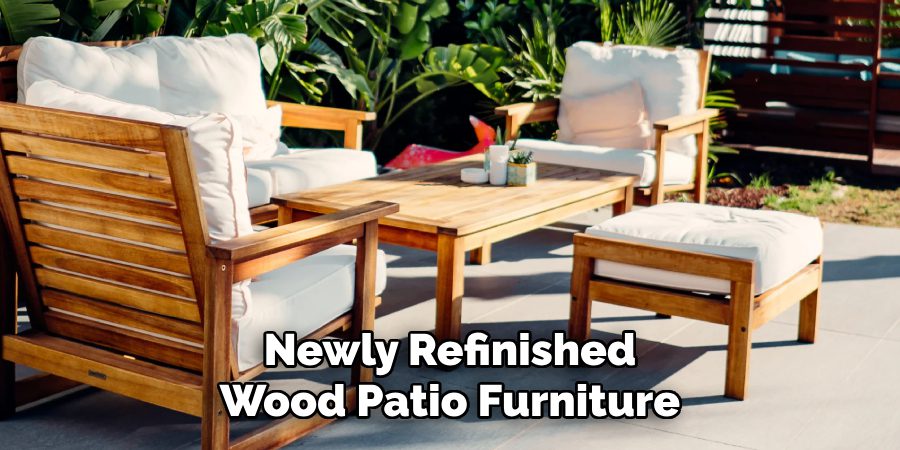Refinishing wood patio furniture is a rewarding project that can breathe new life into your outdoor pieces, making them look fresh and vibrant again. Over time, exposure to sunlight, moisture, and general wear can take a toll on wood furniture, causing it to lose its luster and durability.
By following a few straightforward steps on how to refinish wood patio furniture, you can restore the beauty and functionality of your patio furniture, ensuring it remains a centerpiece of your outdoor space for years to come.

Why Refinish Wood Patio Furniture?
Before diving into the steps of refinishing, it’s essential to understand why you should refinish your wood patio furniture in the first place. Here are a few reasons:
Protection:
Refinishing helps to protect your furniture from the elements, such as rain, sun, and even insects. By applying a protective finish, you can prevent moisture from seeping into the wood and causing rot or warping. Additionally, the right finish can safeguard against harmful UV rays that can fade the color of your furniture.
Cost-effective:
Instead of buying new patio furniture every few years, refinishing is a cost-effective way to give your existing pieces a fresh look without breaking the bank. With just a bit of time and effort, you can transform old, worn-out furniture into something that looks brand new.
Customization:
Refinishing also offers an excellent opportunity for customization. You can choose different stains or paints to give your furniture a unique look and match it with your outdoor decor. You can also experiment with different finishes to achieve the desired level of shine and protection.

8 Steps on How to Refinish Wood Patio Furniture
Step 1: Prepare Your Work Area
Begin by selecting a well-ventilated and spacious area for your project. Outdoor spaces like a backyard or driveway are ideal, as they provide fresh air and minimize mess indoors. Lay down a drop cloth or plastic sheeting to protect the ground from dust, paint, or stain spills. Ensure that your work surface is stable and at a comfortable height for the refinishing process.
Remove any cushions, covers, or non-wooden parts from the furniture to avoid damage. Finally, gather all necessary tools and materials, such as sandpaper, a brush, safety goggles, gloves, and the wood finish of your choice, so you can work efficiently without interruptions.
Step 2: Inspect and Clean the Furniture
Carefully inspect your wood patio furniture for any damage, such as cracks, loose joints, or signs of rot. Address these issues before proceeding; for instance, use wood filler to repair minor cracks and secure loose joints with wood glue or screws. Once the inspection is complete, clean the furniture thoroughly to remove dirt, dust, and other debris that can interfere with the refinishing process.
Use a soft brush or cloth with a mixture of mild soap and water to scrub the surface gently. For stubborn stains or mildew, consider adding a small amount of vinegar to the cleaning solution. Rinse the furniture with clean water and allow it to dry completely before moving on to the next step.
Step 3: Sand the Furniture
Sanding is a crucial step in refinishing wood patio furniture, as it helps to remove any old finish, dirt, and imperfections from the wood surface. Begin by using coarse-grit sandpaper (around 80-100 grit) to strip off the previous coating, making sure to follow the direction of the wood grain. Then, gradually progress to fine-grit sandpaper (around 220 grit) for a smoother finish.
Note: If you have an older piece of furniture with lead-based paint or stain, consider taking safety precautions such as wearing a mask and using a sander with HEPA filters.
Step 4: Repair Any Imperfections
After sanding, take the time to repair any imperfections in your wood patio furniture to ensure a smooth, polished final result. Examine the surfaces for cracks, holes, or other damage that might have been uncovered during sanding. Use wood filler to fill in small cracks and holes, applying it with a putty knife for precision. Allow the filler to dry completely according to the manufacturer’s instructions before sanding the repaired areas lightly with fine-grit sandpaper to create a seamless surface.
For larger issues, such as deep cracks or structural damage, consider using wood glue and clamps or replacing severely damaged sections. Properly repairing imperfections will enhance the durability and appearance of your refinishing project.

Step 5: Apply a Wood Stain or Paint
Now, it’s time to add color and protection to your wood patio furniture with a stain or paint of your choice. Using a brush, apply the stain or paint evenly, following the direction of the wood grain. For a more vibrant color, consider applying multiple coats, allowing each layer to dry completely before adding another.
Note: If you prefer a natural look for your wood furniture, skip this step and move on to the next one.
Step 6: Add a Protective Finish
To protect your furniture from moisture and UV rays, apply a protective finish over the stained or painted surface. There are various options available, such as polyurethane, varnish, or sealant. Choose a finish that is suitable for outdoor use and follow the manufacturer’s instructions for application. Use a brush to spread the finish evenly, working in small sections at a time.
Note: If you opted for a natural look, make sure to choose a clear, water-resistant finish instead.
Step 7: Allow the Finish to Dry
Once you have applied the protective finish, it is essential to allow it to dry completely to ensure the best results. Place the furniture in a well-ventilated area, away from direct sunlight, dust, and debris, as these can interfere with the drying process.
Depending on the type of finish you use, drying times can vary. Refer to the manufacturer’s guidelines to determine how long it will take for the finish to cure fully. Avoid using or moving the furniture until the finish is completely dry to prevent smudging or damage to the protective layer. Patience during this step will help achieve a durable and long-lasting result.
Step 8: Reassemble and Enjoy Your Refinished Furniture
Once the finish is dry, you can reattach any non-wooden parts that were removed in step one, such as cushions or covers. Move your beautiful, newly refinished wood patio furniture back to its designated spot and enjoy it with family and friends. With proper maintenance, your furniture will continue to look great for many years to come.
Following these steps on how to refinish wood patio furniture will help you achieve beautifully refinished wood patio furniture that is both visually appealing and protected from the elements. Remember to take your time, follow safety precautions, and choose high-quality materials for the best results. Happy refinishing!

Frequently Asked Questions
Q1: How Often Should I Refinish My Wood Patio Furniture?
The frequency of refinishing depends on factors such as the type of wood, its exposure to the elements, and the quality of the original finish. On average, wood patio furniture may need to be refinished every 1-3 years to maintain its appearance and durability. Regular maintenance, such as cleaning and applying protective coatings, can help extend the time between refinishing.
Q2: Can I Refinish My Wood Patio Furniture Without Sanding?
While sanding is an essential step in the refinishing process, there are some alternatives such as using a chemical stripper or pressure washing. However, these methods may not be as effective as sanding and can be more time-consuming and costly. It is best to consult with a professional if you are unsure about which method to use.
Q3: Is It Better to Paint or Stain My Wood Patio Furniture?
The decision to paint or stain your wood patio furniture ultimately depends on personal preference and the look you want to achieve. Both options provide protection against the elements, but paint offers more color choices and can cover imperfections, while stain enhances the natural beauty of wood. Consider the type of wood you are working with, as some types may be better suited for one option over the other.
Q4: How Can I Protect My Refinished Wood Patio Furniture From Fading?
To prevent your refinished wood patio furniture from fading, consider using a protective finish that contains UV inhibitors to block out harmful rays. Additionally, regularly cleaning and maintaining your furniture can help prolong its color and protect it from fading. Keep furniture covered or indoors when not in use to further protect it from sun exposure.

Conclusion
Refinishing wood patio furniture is a rewarding DIY project that allows you to give new life to old pieces without breaking the bank. By following these eight steps on how to refinish wood patio furniture, you can transform worn-out furniture into a beautiful addition to your outdoor space.
Whether you choose to stain or paint your furniture, make sure to use a protective finish for long-lasting results. With proper care and maintenance, your refinished wood patio furniture will continue to bring joy and functionality for years to come.
Professional Focus:
Arden Bernier is dedicated to exploring and advancing patio design and maintenance, combining practical knowledge with innovative solutions. Specializing in outdoor living spaces, he provides expert advice on patio fixes, landscaping, and sustainable outdoor design. With a focus on creating functional, aesthetic, and durable outdoor environments, Arden empowers homeowners to transform their patios into beautiful and relaxing retreats.
Vision:
To inspire and assist homeowners in creating functional, aesthetically pleasing outdoor spaces. Arden encourages creativity and practical problem-solving in patio design, making outdoor living more accessible and enjoyable for everyone.
Education:
- Bachelor of Arts (BA) in Environmental Design – University of California, Berkeley.
- Master of Science (MS) in Landscape Architecture – University of Southern California.
- Specialized training in sustainable landscape design, outdoor space planning, and eco-friendly materials.
Recognition:
- Author at PatioFixes.com, providing expert advice on patio maintenance and design.
- Featured in online platforms and home improvement blogs for valuable tips on patio fixes and outdoor living.
- Recognized for his contributions to making outdoor spaces more eco-friendly and sustainable.
Expertise:
Patio expert with a focus on creating functional, beautiful, and durable outdoor living spaces. Specialization includes:
- Patio design and construction
- Outdoor furniture and décor
- Landscaping and sustainable patio solutions
- Outdoor maintenance and repair techniques
